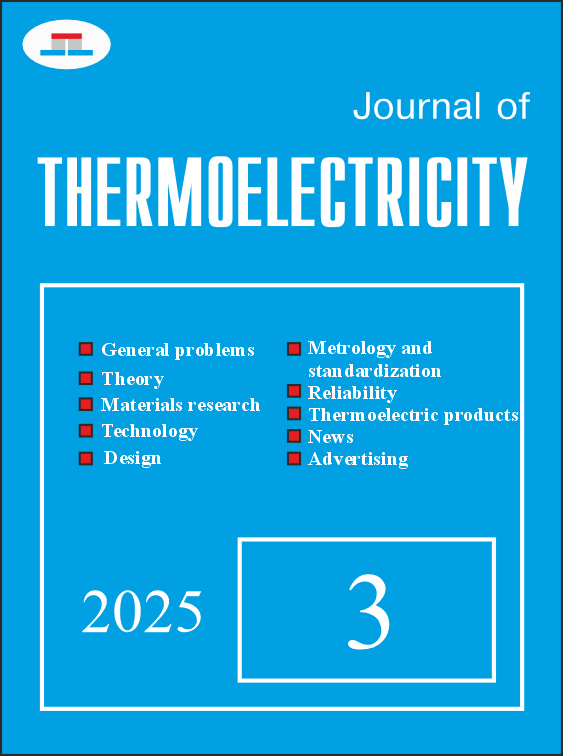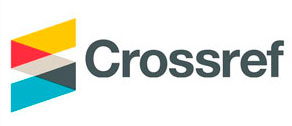Role of Acoustic Phonons in Forming Thermophysical Properties of PbI2 Nanofilms
DOI:
https://doi.org/10.63527/1607-8829-2025-3-5-17Keywords:
nanostructures, nanofilm, lead diiodide, acoustic phonons, thermophysical properties, heat capacity, thermal diffusion, free energyAbstract
Based on the dispersion dependences of acoustic phonon frequencies in hexagonal quasi-two-dimensional nanostructures, previously obtained by us in the elastic continuum approximation, the heat capacity, entropy, free energy (Helmholtz) and thermal diffusion coefficient of nanometer-thick planar structures (nanofilms) of lead diiodide were calculated. The dependence of these quantities on the thickness of the nanofilm and temperature, as well as the role of different branches of the phonon spectrum in the formation of the thermophysical properties of such structures, was studied.
The results of the calculation of the heat capacity, entropy, free energy and thermal diffusion coefficient of lead diiodide nanofilms indicate that they all depend on the thickness of the nanofilm. This dependence is especially pronounced in ultrathin (up to 8 layered packages of PbI2) nanofilms. The absolute values of all the indicated quantities increase with increasing temperature in nanofilms of any thickness. In the low temperature range, the rate of their growth is lower, the thinner the nanofilm. At temperatures above the Debye temperature, the growth of heat capacity and entropy slows down; the CV(T) dependence practically disappears, and the rate of growth of entropy S decreases the more strongly the greater the thickness of the nanofilm. Due to the difference in the rates of change of entropy in nanofilms of different thicknesses in the region T ~ 400 K, the inversion of the S(T) dependence occurs - the entropy acquires values that are greater, the thinner the nanofilm. The rate of change of the free energy value upon reaching the Debye temperature acquires its greatest value, so that with further increase in temperature, the free energy changes according to a linear law with a rate whose magnitude practically does not depend on the thickness of the nanofilm. It is shown that the greatest influence on thermophysical processes controlled by the values of heat capacity, entropy and free energy is exerted by phonons of transverse polarizations - shear and bending. The phenomenon of thermal diffusion, like thermal conductivity, is determined mainly by longitudinal - dilational phonons.
References
1. Anatychuk L., Lysko V., Prybyla A. (2022). Rational areas of using thermoelectric heat recuperators. Journal of Thermoelectricity, (3-4), 43–67. https://doi.org/10.63527/1607-8829-2022-3-4-43-67.
2. Anatychuk L., Prybyla A., Korop M., Kiziuk Y., & Konstantynovych I. (2024). Thermoelectric power sources using low-grade heat: Part 1. Journal of Thermoelectricity, (1–2), 90–96. https://doi.org/10.63527/1607-8829-2024-1-2-90-96
3. Anatychuk L., Prybyla A., Korop M., Kiziuk Y., & Konstantynovych I. (2024). Thermoelectric power sources using low-grade heat : Part 2. Journal of Thermoelectricity, (3), 36–43. https://doi.org/10.63527/1607-8829-2024-3-36-43.
4. Anatychuk L., Prybyla A., Korop M., Kiziuk Y., & Konstantynovych I. (2024). Thermoelectric power sources using low-grade heat: Part 3. Journal of Thermoelectricity, (4), 61–68. https://doi.org/10.63527/1607-8829-2024-4-61-68.
5. Mamykin S., Dzundza B., Shneck R., Vikhor L., & Dashevsky Z. (2025). Development of solar energy systems based on high performance bulk and film thermoelectric modules. Journal of Thermoelectricity, (1), 60–80.
https://doi.org/10.63527/1607-8829-2025-1-60-80.
6. Peng B., Mei H., Shao H., et al. (2019). High thermoelectric efficiency in monolayer PbI2 from 300 K to 900 K. ArXiv: 1811.04244v2 [cond-mat.mtrl-sci].
https://www.osti.gov/servlets/purl/1556115.
7. Gao P., Grätzel M., Nazeeruddin M.K. (2014). Organohalide lead perovskites for photovoltaic applications. Energy Environ. Sci. 7 (8), 2448–2463.
DOI:10.1039/C4EE00942H.
8. Nandi P., Giri Ch., Joseph B., et al. (2016). CH3NH3PbI3, A potential solar cell candidate: Structural and spectroscopic investigations. J. Phys. Chem. A 120 (49), 9732–9739. https://doi.org/10.1021/acs.jpca.6b09718.
9. Zheng H., Dai J., Duan J. et al. (2017). Temperature-dependent photoluminescence properties of mixed-cation methylammonium–formamidium lead iodide [HC(NH2)2]x[CH3NH3]1−xPbI3 perovskite nanostructures. J. Mater. Chem. C 46(5), 12057–12061. https://doi.org/10.1039/C7TC04146B.
10. Rothmann M.U., Lohmann K.B., Borchert J., et al. (2023). Atomistic understanding of the coherent interface between lead iodide perovskite and lead iodide. Adv. Mater. Interfaces 10(28), 2300249. https://doi.org/10.1002/admi.202300249.
11. Liu X., Ha S.T., Zhang Q., et al. (2015). Whispering gallery mode lasing from hexagonal shaped layered lead iodide crystals. ACS Nano 9(1), 687–695. https://doi.org/10.1021/nn5061207.
12. Naseri M., Hoat D.M., Salehi K., Amirian S. (2020). Theoretical prediction of 2D XI2 (X = Si, Ge, Sn, Pb) monolayers by density functional theory. J. Mol. Graph. Model. 95, 107501. https://doi.org/10.1016/j.jmgm.2019.107501.
13. Hu Y. F., Yang J., Yuan Y. Q., & Wang J. W. (2019). GeI2 monolayer: a model thermoelectric material from 300 to 600 K. Phil. Magazine 100(6), 782–796. https://doi.org/10.1080/14786435.2019.1699670.
14. Lu N., Guan J. (2022). Thermoelectric performance of XI2 (X = Ge, Sn, Pb) bilayers. Chinese Phys. B 31, 047201. DOI 10.1088/1674-1056/ac474C.Liu, X., Ha, S.T., Zhang, Q., et al. (2015). Whispering Gallery Mode Lasing from Hexagonal Shaped Layered Lead Iodide Crystals. ACS Nano 9(1), 687-695. https://doi.org/10.1021/nn5061207.
15. Zhong M., Zhang S., Huang L., et al. (2017). Large-scale 2D PbI2 monolayers: experimental realization and their band-gap related properties. Nanoscale 9(11), 3736–3741. DOI:10.1039/C6NR07924E.
16. Zheng W., Zhang Z., Lin R., et al. (2016). High-crystalline 2D layered PbI2 with ultrasmooth surface: liquid-phase synthesis and application of high-speed photon detection. Adv. Electron. Mater. 2(11), 1600291. DOI:10.1002/aelm.201600291.
17. Wangyang P., Sun H., Zhu X., et al. (2016). Mechanical exfoliation and Raman spectra of ultrathin PbI2 single crystal. Mater. Lett. 168, 68–71. DOI:10.1016/j.matlet.2016.01.034.
18. He K., Zhu J., Li Z. et al. High-sensitive two-dimensional PbI2 photodetector with ultrashort channel. Front. Phys. 18, 63305 (2023) (Special Topic: Two-dimensional Electronic Materials and Devices ISSN: 2095-0462 (Print) 2095-0470 (Online)). https://doi.org/10.1007/s11467-023-1323-1
19. Shach K.S., Olschner F., Moy L.P., et al. (1996). Lead iodide X-ray detection systems. Nuclear Instruments and Methods in Physics Research Section A: Accelerators, Spectrometers, Detectors and Associated Equipment. 380(1–2), 266-270. ISSN 0168-9002, https://doi.org/10.1016/S0168-9002(96)00346-4.
20. Shah K.S., Bennett P., Klugerman M., et al. (1997). Lead iodide optical detectors for gamma ray spectroscopy. IEEE Transactions on Nuclear Science 44(3), 448–450. doi: 10.1109/23.603688.
21. Lutsiuk Yu.V., Kramar V.M., Konstantynovych I.A., Voitsekhivska O.M. (2025). Effect of acoustic phonons on thermoelectric properties of lead iodide nanofilms. Journal of Thermoelectricity, 2, 5–16. https://doi.org/10.63527/1607-8829-2025-2-5-16.
22. Zincenco N.D., Nika D.L., Pokatilov E.P., and Balandin A.A. (2007). Acoustic phonon engineering of thermal properties of silicon-based nanostructures. J. Phys.: Conf. Ser. 92, 012086. DOI: 10.1088/1742-6596/92/1/012086.
23. Balandin A.A., Pokatilov E.P., Nika D.L. (2007). Phonon engineering in hetero- and nano-structures. J. Nanoelectron. Optoelectron. 2, 140-170.
https://doi.org/10.1166/jno.2007.201.
24. Lutsiuk Yu.V., Kramar V.M. (2020). Analytical calculation of frequency spectrum and group velocities of acoustic phonons in quasi-two-dimensional nanostructures. J. Nano-Electron. Phys. 12 (5). 05033. DOI:10.21272/jnep.12(5).05033.
25. Lutsiuk Yu., Kramar V., Petryk I. (2022). Frequency spectrum and group velocities of acoustic phonons in PbI2 nanofilms // Phys. Chem. Solid St. 23 (3). 478–483. https://doi.org/10.15330/pcss.23.3.478-483.
26. Bolen E., Deligoz E., Ozisik H. (2021). Origin of low thermal conductivity in monolayer PbI2. Solid State Communications 327, 114223. https://doi.org/10.1016/j.ssc.2021.114223.
27. Pokatilov E.P., Nika D.L., Balandin A.A. (2003). Phonon spectrum and group velocities in AlN/GaN/AlN and related heterostructures. Superlattices and Nanostructures 33, 155–171. https://doi.org/10.1016/S0749-6036(03)00069-7.
28. Sears W.M., Morrison J.A. (1979) Low temperature properties of PbI2. J. Phys. Chem. Solids 40, 503–508.
29. Silva T.S., Alves A.S., Pepe I. et al. (1998). Thermal diffusivity of lead iodide. J. Appl. Phys.83(11), 6193–6195.
30. Dean J.A. Lange’s Handbook of Chemistry, 12th ed. Part: Standard Thermodynamic Values at 25 °C. McGraw-Hill: N.Y., 1979. P. 9-4 – 9-94.
https://www.drjez.com/uco/ChemTools/Standard%20Thermodynamic%20Values.pdf
31. Kubaschewski O. and Evans L.L. Metallurgical Thermochemistry. Pergamon: London, 1958. P. 304.
32. Cröll A., Tonn J., Post E., et al. (2017). Anisotropic and temperature-dependent thermal conductivity of PbI2. J. Cryst. Growth, 466, 16–21.




